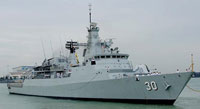 The Royal Malaysian Navy (RMN) has selected the Terma SCANTER 6000 radar as the combined navigation and helicopter control radar for its two Lekiu-class frigates mid-life modernization and service life extension.
The Royal Malaysian Navy (RMN) has selected the Terma SCANTER 6000 radar as the combined navigation and helicopter control radar for its two Lekiu-class frigates mid-life modernization and service life extension.
According to Jesper Tolstrup, Director, Radar Applications, Terma, the high-resolution SCANTER 6000 radar will enable the frigates to detect and track small targets – from the horizon all the way up to the ship itself – on the surface and in low-level air space, and in all weather conditions.
He commented, “In addition to surveillance and navigation, the radar is very capable for controlling helicopters. This is especially important aboard aircraft that do not have their own radar, allowing for the approach and landing on the ship or at remote locations, and do so safely in darkness, poor visibility, or bad sea conditions.”
Tolstrup added, “The SCANTER 6000 will also provide a data feed to the BAE System Nautis combat system on the frigates.”
The SCANTER 6000 is a coherent X-Band 2D solid state radar that has been specifically designed as an affordable all-weather sensor solution to plug the gap between standard marine navigation radars and more expensive military surveillance radar systems. It is very versatile, and has the capability to control aircraft and increase tactical options and safety.
The radar is useful for threat detection and conducting search and rescue. The two 2,270 ton LEKIU-class frigates were commissioned in 1999 and are now undergoing mid-life modernization and service life extension. The radar is being be integrated with the Northrop Grumman Sperry Marine Vision Master automatic radar plotting aid (ARPA) display system.
The RMN has also selected the SCANTER 6000 for its two new Multi-Purpose Common Support Ships (MPCSS). Malaysia has 4,765 km of coastline. Along with neighboring Indonesia and Singapore, Malaysia sits astride the Malacca Straits, one of the busiest shipping lanes in the world. The RMN operates in an ‘extreme littoral’ environment, marked by varied environmental conditions, heavy traffic volume, and short reaction times.
